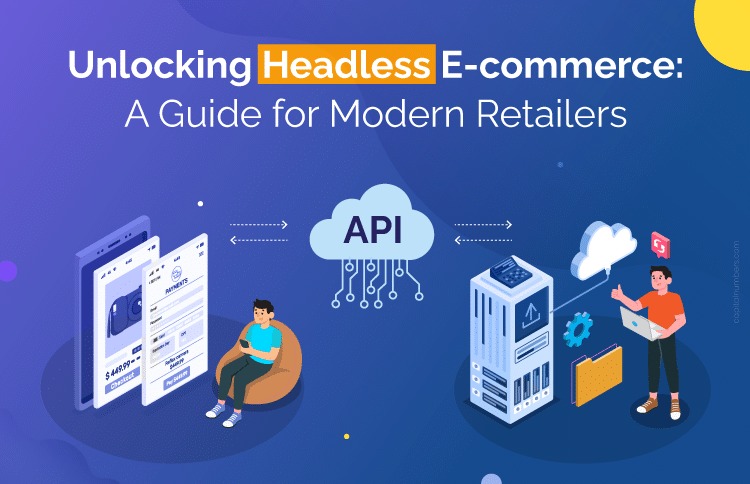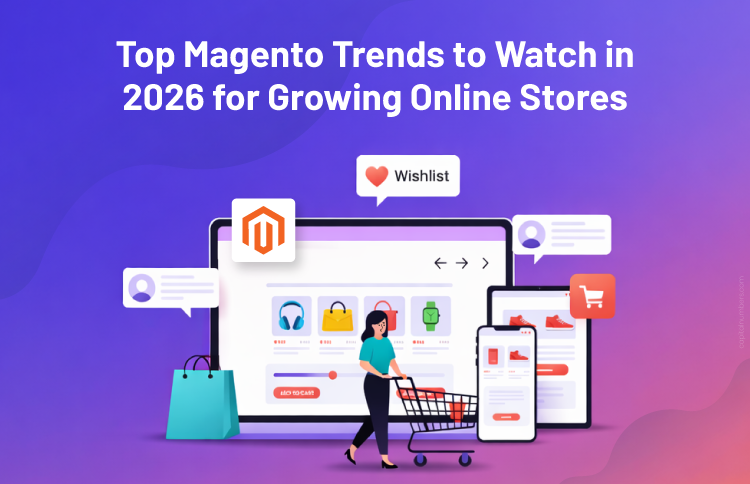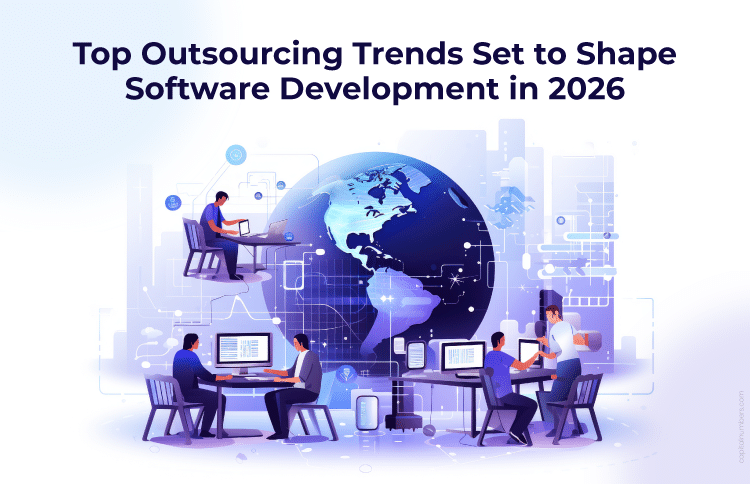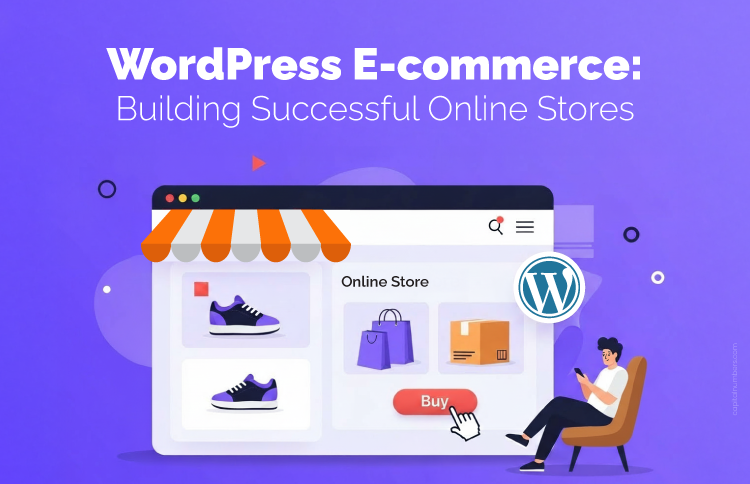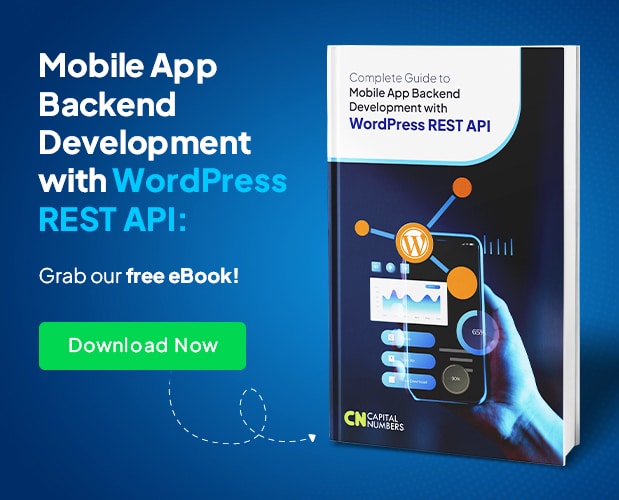Unlocking Headless E-commerce: A Guide for Modern Retailers
Table of Contents
Imagine having an online store that isn’t restricted by its backend system, allowing you to innovate and customize the user experience freely. Welcome to the world of headless e-commerce. As the digital market changes, businesses need flexible and scalable solutions to keep up. Headless e-commerce offers this flexibility by breaking away from traditional e-commerce setups. In this blog, we’ll explain how headless e-commerce is changing online retail, helping businesses provide smooth, personalized experiences that keep customers coming back.
Ready to see how headless e-commerce can transform your e-commerce strategy? Let’s get started.
What is Headless E-commerce?
“Headless e-commerce” is an e-commerce approach where the frontend (what users see) is separate from the backend operations. This allows for a more flexible and customized user interface (UI) compared to traditional e-commerce platforms, which combine both frontend and backend technologies.
In a typical e-commerce system, the frontend (user interface) and backend are tightly linked. This means that changes to the frontend often require changes to the backend, and vice versa. This connection can limit flexibility and slow down innovation in improving the user experience and meeting market demands.
Key Components of Headless E-commerce
- Backend Commerce Functionality: The headless e-commerce backend has all the key features needed for an e-commerce platform, like payment processing, product catalog management, inventory management, and order processing. By separating the backend from the frontend, businesses can handle these core functions without affecting how the user interface (UI) looks to customers.
- Frontend Presentation Layer: The front end is the part of the application that users see and interact with. It includes everything they view and use on the app or website. In headless e-commerce, the frontend and backend are separate, allowing companies to use different tools and technologies for designing and delivering content. This separation helps companies create user experiences that better match their brand and target audience.
- API-based Communication between the Two: In headless e-commerce, APIs (Application Programming Interfaces) help the frontend and backend communicate easily. APIs act as bridges, allowing data and commands to move between the user interface and the backend functions. They set the rules for how different software parts talk to each other. This API-driven method creates a more flexible and scalable system than traditional e-commerce platforms, making it easier to integrate and manage multiple systems and services.
What are the Benefits of Headless E-commerce?
Headless commerce is a modern e-commerce approach that offers many benefits over traditional systems. This section explores the advantages of using a headless e-commerce setup.
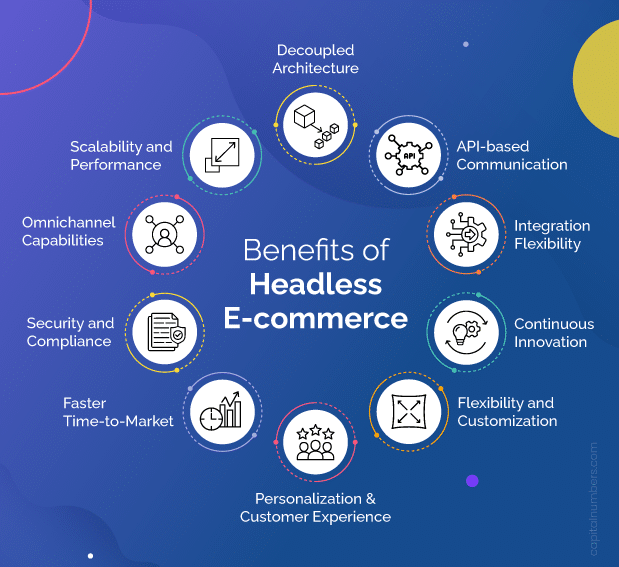
- Decoupled Architecture:
- Flexibility in Designing User Interfaces: One of the main benefits of headless e-commerce is that it allows businesses to create and update user interfaces (UI) separately from backend processes. This separation lets businesses try out new UI designs and features without changing the core business functions.
- Freedom to Innovate and Customize: When the frontend and backend are separated, businesses can innovate faster. They can personalize interactions, add new features, and improve user experiences based on real-time data and user feedback.
- API-based Communication:
- Role of APIs: APIs connect the backend functions and the frontend display in headless e-commerce. They set the rules and methods for different software parts to talk to each other, allowing smooth data exchange and interaction.
- Examples of API Endpoints: APIs enable many features in headless e-commerce, such as order fulfillment, accessing product information, processing payments, and managing shopping carts. For example, APIs can provide real-time inventory data, connect to payment systems, or sync customer profiles across different channels.
- Flexibility and Customization:
- Use of Different Frontend Frameworks: With headless e-commerce, businesses can use various frontend frameworks or native mobile app development frameworks. This flexibility allows them to customize the user interface to meet their specific needs for responsiveness, performance, and user experience.
- Tailoring User Experiences: Businesses can tailor the user experience to match their audience’s preferences and brand identity. Headless e-commerce allows for a personalized approach to engaging users across different touchpoints with flexible design, custom content, and easy navigation.
- Omnichannel Capabilities:
- Consistent Shopping Experiences: Headless commerce ensures a consistent shopping experience across different touchpoints like websites, mobile apps, social media, voice assistants, IoT devices, and in-store kiosks. This seamless integration means customers always have the same brand experience, no matter how they interact with the company.
- Importance of Seamless Omnichannel Engagement: Customers expect consistency and convenience across all channels in today’s digital world. Headless e-commerce helps create smooth experiences, allowing customers to switch between online and offline interactions easily.
- Scalability and Performance:
- Handling Increased Transactions and Traffic: Since the frontend and backend are separate, businesses can scale each part independently based on demand. This means systems can handle traffic spikes, more transactions, and increased user interactions without losing efficiency.
- Separate Scaling of Frontend and Backend: By scaling the frontend and backend separately, businesses can make their systems more efficient and better use resources. This approach reduces downtime, speeds up response times, and increases user satisfaction during busy periods.
- Integration Flexibility:
- Integration with Third-party Services: Headless commerce platforms can easily integrate with marketing automation tools, CRM systems, ERP systems, analytics platforms, and other third-party services. This integration enhances e-commerce operations by adding new features, providing data insights, and improving efficiency.
- Enhanced E-commerce Operations: By connecting with external providers, businesses can speed up processes like inventory management, customer relationship management, targeted marketing campaigns, and advanced analytics. This helps them make data-driven decisions and offer better customer experiences.
- Personalization and Customer Experience:
- Utilization of Consumer Data: Businesses can use customer data and behavior insights from headless e-commerce to personalize the shopping experience. By analyzing customer preferences, browsing history, and purchase trends, they can offer tailored content, personalized product recommendations, dynamic pricing, and targeted promotions.
- Dynamic Pricing and Targeted Promotions: Businesses can create personalized offers that match customer interests, improve pricing strategies, and provide relevant discounts using advanced personalization tools. This approach increases customer engagement, boosts conversion rates, and builds long-term loyalty.
- Faster Time-to-Market:
- Quicker Implementation of New Features: Headless commerce’s modular design allows for faster updates and new features. Developers can work independently on the frontend and backend, reducing dependencies and speeding up the release of new features.
- Agility in Development: By testing and releasing new features step-by-step, businesses can quickly respond to market changes, customer feedback, and competition. This agile approach encourages innovation and continuous improvement, helping companies stay competitive in a changing market.
- Security and Compliance:
- Adherence to Industry Regulations: Headless e-commerce solutions focus on security and following industry standards like PCI DSS for secure payments and GDPR for data protection.
- Implementation of Security Measures: Strong security measures like data encryption, access controls, and regular security checks protect important customer data and guard against online attacks. By following strict security practices, businesses can lower the risk of data breaches and build customer trust.
- Continuous Innovation:
- Culture of Ongoing Innovation: Headless commerce allows businesses to quickly adapt to changing customer preferences, market trends, and new technology, encouraging constant innovation.
- Testing and Iteration: In a flexible and scalable setup, businesses can try out new features, integrations, and business models. This approach lets them test ideas, get real-time feedback, and refine strategies to boost performance and drive growth.
Industries Benefiting from Headless E-commerce
Headless e-commerce is transforming how businesses operate and engage with customers across various sectors:
- Retail: Top retail brands are using headless e-commerce to improve omnichannel capabilities, provide personalized shopping experiences, and streamline inventory management. Major retail brands have started using headless architecture to provide seamless user experiences on their mobile apps, websites, and digital kiosks within stores.
- Fashion: Fashion brands are using headless e-commerce to release new collections faster, customize recommendations based on client preferences, and connect with social media channels for better brand interaction.
- Electronics: Electronics companies are using headless e-commerce to manage complex product catalogs, connect with IoT devices, and provide real-time notifications about product availability.
- Hospitality: Hotels and travel agencies are using headless e-commerce to offer personalized booking experiences, connect with reward programs, and simplify reservation management across various channels.
- Automotive: Automakers and dealerships are using headless e-commerce to enhance the online car-buying experience, connect with CRM systems for lead management, and offer virtual test drives with AR/VR technology.
Challenges and Considerations in Headless E-commerce
- Implementation Complexity:
- Initial Setup and Integration Challenges: The separation of frontend and backend systems required to implement a headless e-commerce architecture may present initial integration issues. To guarantee smooth functioning, businesses might need to move data or rework current systems.
- Requirement for Technical Expertise: A team possessing strong technical knowledge in frontend development, backend integration, and API maintenance is necessary for the successful deployment of a headless e-commerce system. For the purpose of managing complexity during setup and continuous maintenance, businesses need to invest in trained personnel.
- Cost Implications:
- Investment in Development and Maintenance: Setting up a headless e-commerce architecture requires an upfront development commitment, which includes integrating backend features and configuring frontend interfaces. The expenditures of updates, security patches, and API administration are also included in ongoing maintenance.
- Long-term Cost Savings vs. Short-term Expenses: Businesses can save money in the long run with headless e-commerce, even though the initial costs may be higher due to development and integration. Benefits include the ability to scale without rebuilding systems, less dependence on single platforms, and the flexibility to add new features and technologies over time.
- Choosing the Right Platform:
- Factors to Consider: When choosing a headless e-commerce platform, businesses should consider scalability, API flexibility, ease of integration with existing systems, security features, and support for omnichannel experiences.
- Comparison of Popular Solutions: Platforms like commercetools, BigCommerce headless, and Magento Commerce offer strong headless e-commerce solutions. Each platform has different features, scalability options, developer support, and pricing. Evaluating these factors helps businesses choose the right platform for their needs and growth plans.
Future of Headless E-commerce
- Trends and Predictions:
- Emerging Trends in Headless E-commerce: Several trends show where headless e-commerce is heading. These include more use of AI and machine learning for personalization, the rise of progressive web apps (PWAs) for better mobile experiences, and integration with IoT devices for smoother customer interactions. Headless architecture will continue to evolve to support these technologies, offering businesses greater flexibility and innovation.
- Predictions for the Future of E-commerce: E-commerce is expected to grow quickly because of more digitization and the convenience of online shopping. Headless e-commerce will play a big role in this growth by helping companies offer personalized omnichannel experiences that meet changing customer needs. Voice shopping is likely to become common, and AR/VR will make shopping more immersive.
- Adoption Rates:
- Growth in Adoption of Headless E-commerce Architecture: Headless e-commerce is becoming popular in many industries. Businesses are seeing the benefits of separating frontend and backend systems, like better scalability, flexibility, and faster time-to-market for new features. The main reasons for this trend are the need to provide seamless omnichannel experiences and stay competitive in the digital economy.
- Influence on the Overall E-commerce Landscape: Headless e-commerce is shaking up traditional e-commerce platforms. More companies are moving to modular, API-driven solutions that let them quickly adapt to market changes. This shift is driving e-commerce towards more dynamic, customer-focused models that prioritize efficiency and user experience.
You May Also Read: AI in E-commerce: Shaping the Future of Customer Engagement
Conclusion
Headless e-commerce is leading the way in online shopping innovation. By separating the frontend from backend functions, businesses can create personalized user experiences, grow operations independently, and connect easily across channels. In today’s digital world, headless e-commerce is essential for managing changes, using new technologies, and improving customer engagement.
Looking to elevate your online store to the next level? Contact us today to discover how our e-commerce development services can create a flexible, scalable, and innovative platform that meets your business needs and delights your customers.

